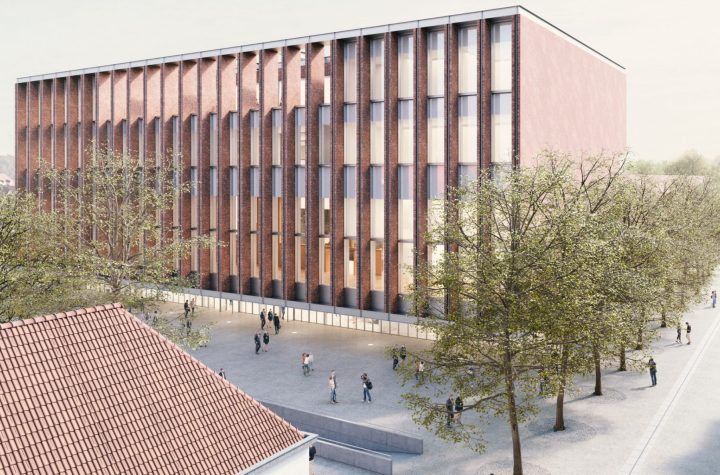If astronauts orbited Mars, this is what they would see.
Astronauts are often amazed when they view the curvature of the Earth from the International Space Station. Now, thanks to NASA’s 2001 Mars Odyssey orbiter, we get an idea of what a similar view looks like around Mars. “This is what astronauts would see if they were in orbit around Mars,” says NASA’s Jonathan Hale. “Until now, no Martian spacecraft has ever been able to see such a view.”
picture
Below you can enjoy the stunning new image of the Martian skyline. The image was taken using the THEMIS infrared camera with which the Mars Odyssey spacecraft is equipped. The spacecraft took the images in May from an altitude of about 400 kilometers. This is the same height at which the International Space Station hovers above Earth.
The spacecraft captured a series of panoramic images showing Mars’ undulating landscape beneath thin layers of clouds and dust. Putting these 10 images together will not only give you a new and impressive view of Mars, but it will also help scientists understand more about the red planet’s atmosphere.
As mentioned earlier, the images were captured using the THEMIS infrared camera. This camera is sensitive to temperature and can map ice, rocks, sand and dust on the planet’s surface, as well as temperature changes. It can also measure the amount of water ice or dust in the atmosphere, but only directly below the spacecraft. This is because THEMIS is stuck in one place on the orbiter and usually looks down.
Martian atmosphere
Through this mission, the researchers wanted to obtain a clearer picture of the Martian atmosphere. They hoped to gather important information about how the layers of clouds, water ice and dust in the Martian atmosphere interact with each other. These insights will be useful to scientists to improve their models of the Martian atmosphere. “I liken it to looking at a cross-section of the atmosphere,” explains Jeffrey Plaut, Odyssey project scientist. “There are a lot of details that you can’t see from above, which is usually the way THEMIS typically makes these measurements.”
Three months of confusion
Taking the photo was quite a challenge. Engineers from NASA (which manages the mission) and Lockheed Martin Aerospace Corporation (who built Mars Odyssey and is involved in managing day-to-day operations) spent three months trying to get the picture done. Since THEMIS cannot rotate, the team had to adjust the position of the entire spacecraft to change the camera angle. In this case, they rotated the orbiter about 90 degrees, making sure that the sun still shone on the solar panels, but not on sensitive equipment that could overheat. The easiest way to do this was to point the orbiter’s antenna away from Earth. This left the team unable to communicate with Odyssey for several hours until the operation was completed.
Phobos
However, the hard work has paid off. Because it produced a truly stunning image of the Martian horizon. And not only that. To make the most of the team’s efforts, Mars Odyssey also immediately captured images of Mars’ small moon Phobos. This is the seventh time in 22 years that the THEMIS orbiter has targeted the Moon to measure temperature differences across the surface. “We got a different perspective and different lighting conditions from Phobos than usual,” Hill says. “This makes it a unique part of our collection of data about Phobos.”

The new images provide important information about the nature and appearance of Phobos. Scientists continue to study the moon, hoping it will help resolve a long-standing controversy. Some believe Phobos, which is about 15 miles (25 kilometers) across, is a captured asteroid, while others see it as an ancient fragment of Mars that was ejected from the surface as a result of the impact. More research is needed to clarify this.
Overall, the beautiful image of the Martian horizon shows the planet from a whole new perspective. This provides important new information. Researchers also plan to take similar images of Mars in the future using Mars Odyssey, as they want to record the Red Planet’s atmosphere during different seasons. Who knows what this could reveal about this still mysterious planet.
More about the 2001 Mars Odyssey spacecraft
Mars Odyssey 2001 is a space probe launched by NASA to study the planet Mars. The main goals of the Mars Odyssey mission are to study the climate and geology of Mars, as well as to search for signs of water and ice on the planet. The orbiter was launched on April 7, 2001 and entered orbit around Mars on October 24, 2001. One of the main instruments on board is the Thermal Emission Imaging System (THEMIS), a camera that captures infrared images of the Martian surface. This makes it possible to study the thermal properties of the surface. The Mars Odyssey mission has an exceptionally long lifespan, completing its 22nd year orbiting Mars in 2023. Overall, the Mars Odyssey mission has already provided a lot of valuable data and images so far that have contributed to a better understanding of the Red Planet.

“Coffee buff. Twitter fanatic. Tv practitioner. Social media advocate. Pop culture ninja.”









More Stories
The city of Bruges hosts the Public Space Conference 2025
Not only are these beautiful moths resistant to highly toxic plants, but they also use the poison to seduce their mate
Meetings “The Power of Memory”